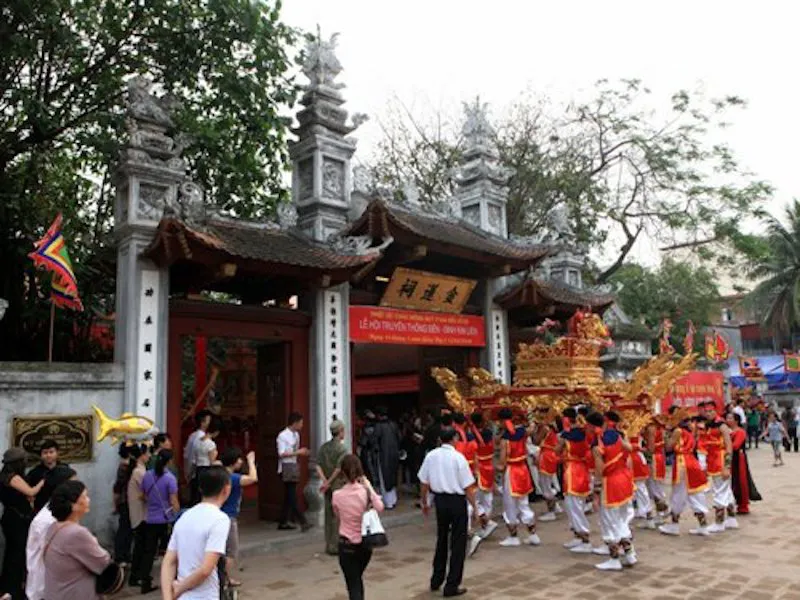Four Protectors of Hanoi
- K
Thang Long Hanoi, a city of thousands of year, has a solid and rich historical background and is believed to be protected by four genies.
Selected as the capital since 1010, Thang Long, or Hanoi today, has stood the test of time beautifully and peacefully for centuries. Its secret relies on the four sacred protectors. They are actually worshiped at four well-known temples in the city. Each embodies a story with its own historical, cultural and architectural values, also showing Vietnamese people’s worshiping tradition of thousands of years in hundreds of sacred places along the country.
| Kim Lien Temple |
Protector of the East: Bach Ma Temple
Legend has it that in 1010, when the capital was moved from Hoa Lu (Ninh Binh province) to Thang Long, King Ly Thai To (974-1028) decided to build a citadel to prevent the invaders. However, every time the construction completed, it collapsed. The king was advised to make offerings at a temple dedicated to a genie named Long Do, the tutelary god of the place.
One night, the genie came to the king in a dream and told him to follow the footsteps of a horse to build the citadel. Then the king saw a white horse galloping out from the temple and then disappeared. The next day, the king ordered the troops to build the citadel following the horse footsteps. Since then, the citadel stood firmly.
To show the gratefulness to the genie, the king ordered a sculpture of a white horse in the temple for worshiping and conferred it the title of ‘Thang Long tutelary god’ and named the temple as Bach Ma, which literally means white horse.
Many restorations have been made and the temple now has typical 19th century architecture. It features a wooden frame and large columns in the main building with three-door gate, a place for burning incense, forbidden chamber and sophisticated effigies. It still keeps lots of old valuable relics such as stone steles, palanquin, cranes and pairs of earthen statues for worshiping.
Every year, to honor the genie, the People’s Committee of the district where the temple is located organizes Bach Ma temple festival on lunar February 12 and 13. The event includes many offerings and cultural activities like ceremonial songs, Vietnamese popular opera, poem recitation and fencing.
Located in Hoan Kiem central district, Bach Ma Temple is easy for tourists to reach by foot.
| Quan Thanh Temple |
Protector of the North: Quan Thanh Temple
Quan Thanh Temple, also known as Tran Vu Temple, was also built in 1010, under the Ly Dynasty with the purpose of worshiping Tran Vu genie, who trained the heaven squad of guards, controlled the North and was believed to help Hung Kings (regarded as the founders of the nation) expel invaders and assist the people in the fight against evil ghosts and natural disasters. This is typical of the tradition of worshiping the genies who have the magic power to build the nation.
By Truc Bach Lake, Quan Thanh Temple is famous for its architecture of the 17th century. It includes three gates, temple yard and the three main buildings of front hall, annex and back halls. Inside Quan Thanh Temple, there is a four-meter height black copper statue of Tran Vu Genie holding a sword on the back of a turtle which reflects strength and longevity. The statue was built in 1677 to show the respect of local people to the genie and the unique representation of the artistic creation of the period.
Besides the statue, the temple is also famous for its wood works such as dragons, phoenix, bats; some kinds of beautiful flowers that show the uniqueness of the art under the Le dynasty in 16th century and Taoism.
| Voi Phuc Temple |
Protector of the West: Voi Phuc Temple
Built in a muddy lagoon in 1065, the temple stands now on a high mound south of the Thu Le Zoo, with a nice view to a large beautiful lake and surrounded by gardens and many luxuriant ancient trees.
Voi Phuc Temple is dedicated to Prince Hoang Chan, also known as Linh Lang Dai Vuong, the son of King Ly Thai Tong (1000–1054). Legend has it that the king was growing old but had no son. One day, one of his wives was bathing in Dam Dam Lake (West Lake now), a dragon suddenly appeared and showered her before disappearing. After a few days, she got pregnant. Fourteen months later, she gave birth to a boy who was named Ling Lang (small dragon) for the black moles twinkling like dragon scales on his body.
When he was about two months old and at his mother's native land in Thu Le Camp, foreign invaders came to the country. The King called on talented people to fight the enemy. When the royal emissary came to Thu Le Camp, Ling Lang suddenly spoke and told his mother that he needed to help his father.
Then the little prince grew up to be an adult and asked the King to send him a red flag, a long spear and an elephant for fighting. When he met the elephant and shouted, it kneeled down in front of him. The prince took the flag, rode the elephant and led an army to the battle.
After the victory, the prince returned to Thu Le and said that he was a genie sent from heaven to help the King defeat the invaders and now he had to be back to the celestial kingdom. He then magically transformed into a serpent and slithered into Dam Dam Lake. The King bestowed the title His Royal Highness on him and built the temple to honor him. In front of the temple are two kneeling elephants, hence the name Voi Phuc of the temple called by the residents.
The temple was heavily damaged under the French colonialism. From 1953 to date, it has been renovated several times. Its architecture still consists of the one of the 19-20th century of the feng shui representing vitality from heaven to earth. Inside, there is a squared-shape well as symbol for the abundant water and prosperity and a couple of wood dragons and tigers.
Besides two elephants kneeling in front of the temple, there is also a collection of cultural artifacts including a throne, bronze temple bells, sedan chairs, ancestral tablets, sculptures of sacred cranes and horses, and valuable objects. Inscriptions in ancient scripts conserved in the temple are filled with many stories of the gods, particularly the tutelary god.
Every year, to commemorate the merits of Linh Lang Genie, Voi Phuc Temple Festival is held on the 9th to the 11th day of the second lunar month. This is a grand procession festival with flags, fans, gongs, drums, parasols, bat am (cantanets) musical band and some group dancing.
Protector of the South: Kim Lien Temple
The youngest protector of the city, built in 1509, is located in Kim Lien village, Dong Da district, to honor Cao Son Dai Vuong, one of the sons of Lac Long Quan and Au Co, the legendary creators of Vietnamese people.
Together with 49 other brothers and sisters, Cao Son followed father Lac Long Quan to the mountain to settle in the land while the 50 others went with mother Au Co to the sea. He is believed to help Son Tinh, the Genie of the Mountain defeat Thuy Tinh, the Genie of the Water in a famous myth of devastating deluge representing the victory of Vietnamese people over the natural disasters in the early days.
Later in the 16th century, King Le Tuong Duc (1495-1516) successfully quelled the rebellions in the country. Before fighting them, he prayed Cao Son for a holly support. After the victory and regained the power for Le House, he built the temple to honor him.
The temple was also destroyed during the wars, however, the important relic of an over-two-meter height stele with a poem honoring Cao Son stood still in a small chamber under an old banyan tree.
On a high hill, the temple consists of two separate parts: the arched gate and the main structure on the hill itself. This was similar to the construction of the Kinh Thien Palace in the Thang Long Imperial Citadel. In front of the yard is a gate with two square bronze pillars near a small spring. This was thought as the meeting-point of water and happiness.
The entrance gate is a three compartment chamber with lively decorative details such as phoenixes keeping books in their beaks, clouds and a unicorn. It also conserved 39 imperial edicts of Le and Nguyen dynasties conferred to Cao Son and several parallel sentences.













